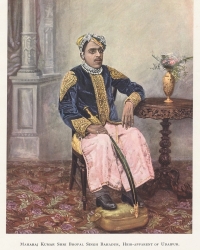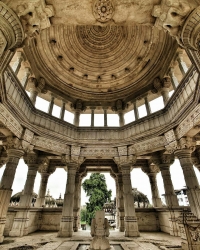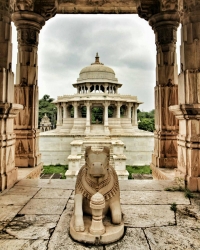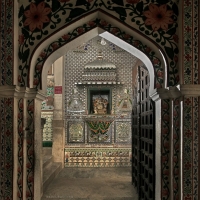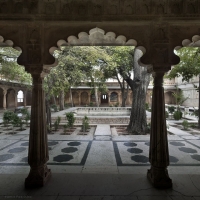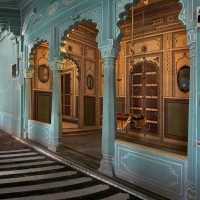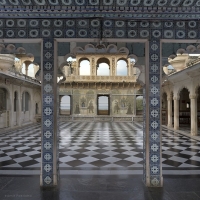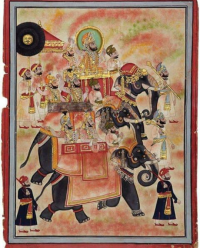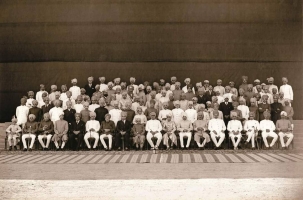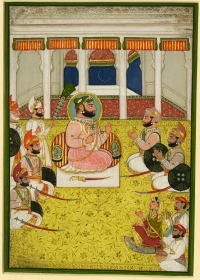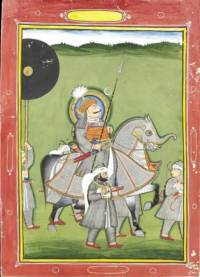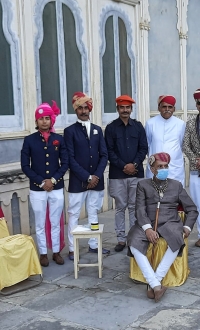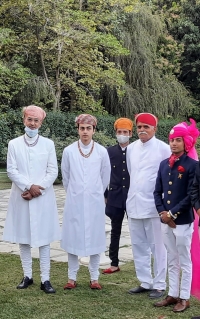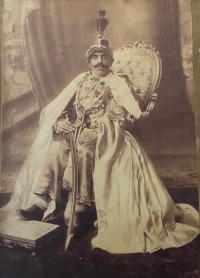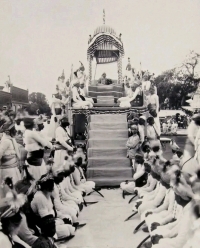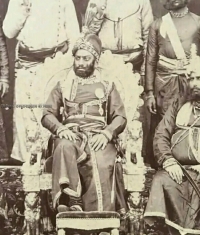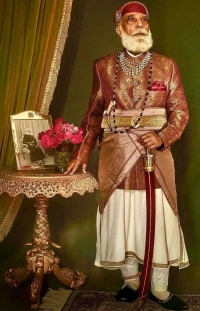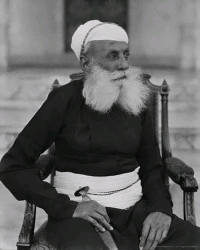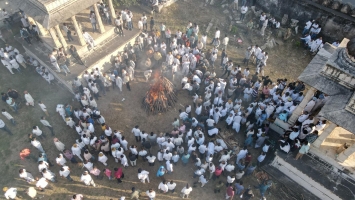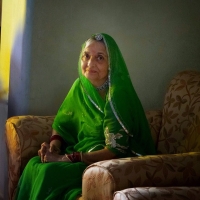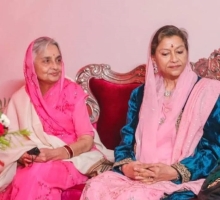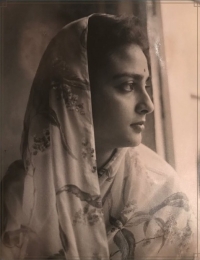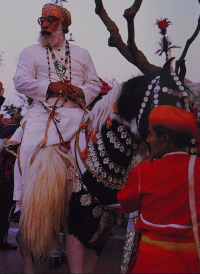Present Head

- Maharajkumari Baijiraj Saheba Jayati Kumari, MSc. Cognitive Neuroscience, Durham University, U.K.
- Maharajkumar Bavjiraj Saheb Devajaditya Singh
History
As the Mughal empire weakened, the Sisodia ranas, and later maharanas (also called the Guhilots or Suryavansh), who had always tried to oppose Mughal dominance, reasserted their independence and recaptured most of Mewar except for Chittor. Udaipur remained the capital of the state, which became a princely state of British India in 1818. Being a mountainous region and unsuitable for heavily armoured Mughal horses, Udaipur remained safe from Mughal influence in spite of much pressure. The rajvansh of Udaipur was one of the oldest dynasty of the world.
Maharana Mokal
Ruling Period: 1421 - 1433
Maharana Mokal was a great builder and he inherited this trait from his father, Maharana Lakha. He created various buildings along with completing those commenced by his father. The duty to transform their motherland thus flowed down the veins of the Sisodiyas.
Maharana Lakha, the 45th Maharana of Mewar died in war leaving young Mokal as his successor. Being a minor, his eldest brother Choonda began to look after the state of affairs as promised to Rana Lakha. But Mokal's mother Hansa Bai did not like the influence that Choonda had over the nobles of Mewar. She questioned his integrity and doubted his intentions. Her resentment made Choonda leave Chittor and retire to Mandu, capital of Malwa. Rani Hansa Bai attained help from her brother Ranmal of Marwar to administer the state of affairs on behalf of Mokal until he was a minor.
Maharana Mokal had a brief stint as the ruler of Mewar but rose to fame as the most celebrated warrior of his race. He defeated Nagour, Gujarat and repelled an invasion by the Delhi Sultan. But most importantly, he completed palaces that were commenced by his father Maharan Lakha and conspired to build more aesthetic structures. But his sad demise at a young age of 24 put a stop to this emerging illustration of Mewar. His assassination by his paternal uncles, Chacha and Mera brought an end to a great Maharana in the making.
Rana Kumbha who was only 13 years old at the time of Mokal's death, ascended the throne at a crucial juncture in the history of Mewar. The young Kumbha may have had the most unfavorable situation after his father's untimely death but the valour and vision of his father, Maharana Mokal inspired him to emerge as one of the greatest rulers Mewar ever knew.
Maharana Kumbha
Ruling Period: 1433 - 1468
Standing in front of the fort of Kumbhalgarh, one cannot resist the awe this glorious fort manifests in it. Sometimes it is difficult to imagine how structures like such were conceived, perceived or built. At a height of 1,100 metres above sea level, this magnanimous structure is a saga of glory, gallant and grandeur. Built by Maharana Kumbha, this fort of Kumbhalgarh remained uncaptured till the end; and is a literal depiction of the Rana himself.
Maharana Kumbha or Kumbhakarna Singh was the eldest son of Maharana Mokal of Mewar and his wife Sobhagya Devi. He ascended the throne after his father was assassinated. He ruled Mewar for thirty five years; the historians often called the era 'the golden period of Mewar'. This heroic ruler of Mewar is remembered and idolised by people for varied reasons. While history remembers him as the powerful man who never lost any battle, the Rajputs consider him as the only Hindu king of the time when the rest of India was under muslim dynasties.
Mewar was the only Hindu-ruled major state allocating its supremacy to Lord Shiva. The powerful Muslim principalities united and aimed to defeat Rana Kumbha but their efforts were thwarted every time by the Rana, single handed. He captured the muslim capital of Rajasthan; Nagaur and established himself as 'The undefeated'.
The Art lovers remember the ruler as a great poet and musician. He was a great scholar and patron of music and wrote extensively on music. He devoted himself to learning and uplifting Indian classical music to preserve the ancient traditions of classical music.
And lastly, the remaining recall him as one of the greatest builders of Mewar, who built across Mewar, nearly thirty two fortresses including the fort of Kumbhalgarh, renowned temple of Ranakpur and the famous Victory Tower or the Vijay Stambha in Chittor to commemorate his victory over the combined armies of Malwa and Gujarat. Maharana Kumbha was killed while he was offering prayers to Lord Shiva.
Maharana Udai Singh I
Ruling Period: 1468 - 1473
The Rajputana land is infused with the courage and bravery of its warrior sons; their blood smeared desert soil is a symbol of Rajputana glory. Mewar produced abundant proud legends; sagas of valour, chivalry and freedom. But every coin has another side and every era dooms in its own darkness. The land of Mewar too had a black sheep of its own.
Born to one of the most celebrated heroes of Mewar, Rana Kumbha, the undefeated Maharana; Prince Uda, Udaikaran or Udai Singh is one of the most despised sons of Mewar. Being the heir to Rana Kumbha, his ascension to throne was imminent. But the power driven young Udai Singh failed to wait to pave his way towards the throne. In an act of patricide, he killed his own father Rana Kumbha; while he was offering prayers to his deity, Lord Eklingji.
With the sad demise of its hero, Mewar was thwarted. Udai Singh proclaimed himself as the new king and came to power. He ruled Mewar for a small span of five years; till he was defeated by his own brother Raimal and had to flee from Mewar. He was a feeble ruler and because of his incompetency, Mewar lost the territories of Abu and Ajmer. He fled to Delhi and offered his daughter to the Sultan of Delhi in marital alliance in return for his support. But fate had its own plans and Udai Singh was struck by lightning before the marriage, and died on the spot.
The legacy of the Suryavanshi kings of Mewar was tarnished by their own son and such was the hatred that many omitted him from the genealogies of Mewar. He was nicknamed murderer and the condemned Rana Udai Singh was diluted in the history.
Maharana Sangram Singh I
Ruling Period: 1509 - 1527
The desert land of Mewar has produced abundant warriors and their heroic legends. The fables of bravery are infused in this desert soil, every time a son of Mewar is born with his own tale to tell. And amongst the numerous was the mighty Maharana Sangram Singh or as the Rajputs gloriously call him Rana Sanga; the king whose demise marked the beginning of Mughal rule and changed the course of Indian history forever.
Rana Sanga succeeded Mewar after the death of his father Raimal and his two brothers. The crisis of succession led Maharana Sangram Singh to the throne, bringing forth another mighty warrior son of Mewar who fought for his kingdom till the last drop of his blood.
Rana Sanga was not only a great warrior who fought invaders gallantly but also a visionary, under whom many Rajput states united and fought the foreigners. He was a warrior with a resolute as strong as his grandfather Rana Kumbha. It is said that despite losing his one arm, one eye and numerous other grave injuries, he continued fighting his enemies. He is also remembered for his chivalry, when he restored the kingdom of Mandu. After defeating Sultan Mahmud of Mandu and taking him as prisoner of war, he treated him and his kingdom with generosity and chivalry.
Rana Sanga fought the rulers of Delhi, Malwa and Gujarat numerous times during his lifetime defeating them on various accounts. After the assassination of Ibrahim Lodi by Babur, the power in Delhi declined and he emerged as the strongest Hindu king of North India. He decided to conquer Delhi; the most prized possession of Muslim rulers, and bring complete India under his rule.
Rana Sanga, united with the Rajputs fought Babur in the battle of Khanwa which proved to be exceedingly brutal and deadly. Although with initial advantage, the Rajputs lost heavily and Rana Sanga who fell unconscious, was whisked away to safety by his men, after gaining his consciousness and knowing about the defeat, he decided to rebuild his army for war injuries. Rana Sanga died soon because of his injuries. Rana Sanga's death established the Mughal rule in India marking a new beginning to the history of Indian subcontinent.
Maharana Udai Singh II
Ruling Period: 1537 - 1572
The history behind a mesmerising city is seldom as beautiful as the city itself. Who hasn't marvelled at the beauty of the city of lakes and not felt romantic? When Maharana Udai Singh II founded the city of Udaipur, one can wonder what splendour he must have felt on discovering this truly gifted part of the planet. He was a true connoisseur of beauty, it seems. Udai Singh II is parallelly remembered for his breathtakinly beautiful queens, who were 20 in mumber. This son of Rana Sanga is invariably famous in the Rajputana history for two reasons; one for being the father of the bravest son of Mewar, Maharana Pratap and secondly for gifting the picturesque city of Udaipur to the world.
Udai Singh II was the fourth son of Rani Karnawati and Maharana Sangram Singh who was popularly known as Rana Sanga. After Rana Sanga's death, his enemies tried to kill Udai Singh II who was only a child at that time. He was rescued by his nurse Panna Dhai who replaced him with her own son and sacrificed his life for the safety of the young prince. Later when he ascended the throne, he was attacked by Akbar. At this time, he had already left Chittor 9 years ago, ending up in Udaipur, giving Mewar its new capital.
The city of lakes "Udaipur"™ is named after its founder, who then made it his capital even before Chittor was sacked by Akbar. When the Mughal forces attacked Chittor, the then capital of Mewar, Maharana Udai Singh II and the royal family had already left for Gogunda, making it a temporary capital until Udai Singh II shifted to Udaipur, making this gem the new capital of Mewar. Although after the weakening of the Mughals, the Rajput kings recaptured most of Mewar but failed to win over Chittor. Thus Udaipur which had been safer from the Mughal influence because of its mountainous terrain remained the capital of Mewar till it became a part of Union of India 1948.
Udai Singh II who is perhaps less famous for his valour or bravery as his ancestors Rana Kumbha or Rana Sanga, became the proud father of Maharana Pratap who marked the Rajputana history with his heroism and courage, making his father's presence in history significant and imperative.
Maharana Pratap Singh
Ruling Period: 1572 - 1597
Maharana Pratap was the son of Maharana Udai Singh of the Sisodiya clan of Rajputs, the rulers of Mewar. Pratap became the ruler of Mewar against his father's wish, who had appointed his favourite son Jagmal as his successor. However, the senior nobles of Mewar decided that Pratap, the first son and rightful successor should be crowned king. Moreover, Maharana Pratap was said to be a man of strong Rajput character, he was far more brave and chivalrous. His kind heartedness and just decision making won the hearts of even his enemies. He is the only ruler of India that did not give in to the Mughal rule, and for that he is the most celebrated ruler of the country to this day.
After the famous battle of Haldighati, Maharana Pratap's own brother, Shakti Singh, who had joined the Mughals helped him escape the battlefield, as his beloved and trusted horse Chetak was wounded in his hind leg and Jhala Man a noble was wearing the Maharana's crown as decoy. Chetak, Maharana Pratap's trusted horse, delivered him to safe grounds before breathing his last. Pratap had to take refuge in the Aravalli hills. The Bhil tribals of the Aravallis supported Maharana during times of war, and helped him in living off the forests during times of peace. In exile, Pratap spent considerable time perfecting war tactics like guerilla warfare, harassing the enemy and light horse tactics which helped him win back Mewar.
Col. Tod, the famous British antiquarian, gave Pratap the title of 'Leonidas of Rajasthan'. In one of his writings on Pratap, Tod mentioned that, 'There is not a pass in the Alpine Aravalli that is not sanctified by some deed of Maharana Pratap some brilliant victory, or oftener, more glorious defeat.' It is believed that during his exile, Maharana Pratap, was at breaking point. A Rajput poet and warrior, Prithiraj of Bikaner who was at Akbar's court sent a letter to the Maharana giving him strength, and steered him to carry on his war efforts.
Maharana Pratap died at the age of 57, after sustaining a injury while hunting.
Rana Amar Singh I
Ruling Period: 1597 - 1620
Maharana Amar Singh I was the eldest son and successor of Maharana Pratap. He was the 13th Ruler of Mewar dynasty of Sisodiya Rajputs. Maharana Pratap, on his death bed, made his successor swear to him in front of his chiefs to maintain their fight against the Mughals and to re-conquer Chittor. From his childhood to the days of Pratap's death, Amar had been a constant companion in his valiant father's toils and troubles. He proved to be a great warrior in the battle of Dewair, wherein, Amar Singh killed the Mughal commander in charge, Sultan Khan. It is believed that he thrust his spear with such force that the weapon struck in the ground after piercing the strong coat of mail and the horse of Sultan Khan. Mewar was victorious and Pratap was able to claim back much of the lost territories of Mewar, but not Chittor. Amar Singh, a dutiful son fought many battles with the Mughals during his lifetime, both against Akbar and Jahangir to fulfill his father's last wish.
Maharana Amar Singh unfortunately reached a breaking point after the attack lead by Shah Jahan which caused much damage to life and property of Mewar. Temples were destroyed, several villages put on fire and ladies and children were captured and tortured to make Amar Singh surrender. In pure interest of his people and Mewar, he made a diplomatic move. The treaty between Amar Singh and Jahangir stands on a different plain as against any other treaty between a Mughal Ruler and a Rajput Chief of Rajasthan. Whereas other Rajput rulers were required to attend the Imperial Darbar in person, the Rana was exempted from such a duty. The territories around Chittor along with the Chittorgarh Fort were given back to Mewar in 1616 by Jehangir, as a goodwill gesture. The treaty of 1615 A.D. terminated almost a century-old struggle between two legendary ruling houses.
Rana Karan Singh
Ruling Period: 1620 - 1628
Karan Singh was the successor to Rana Amar Singh, and was crowned king of Mewar in 1620. Karan had often proved his courage and bravery in battles commanded by his father; soon he was to show ability in repairing the damage of former adversities. As a part of the treaty between Rana Amar Singh and Jahangir in 1615, Karan Singh, as the crown prince became a part of the Mughal council. Thereafter, Karan acclaimed distinction among the Rajput underlings of the Mughals. A man of vision, Maharana Karan Singh began rebuilding his capital. He added many rooms, courtyards and halls to the City Palace. He constructed the Zenana Mahal (Palace of the Queens), for the private use of the court's ladies. The city's walls were fortified; Lake Pichola's dam was strengthened and the lake enlarged. Rana Karan Singh became the chief advisor and friend of Prince Khurram to be known as Emperor Shah Jahan later. It is believed that when the Mughal Prince was exiled by his father, Emperor Jahangir, he turned to the Maharana for help and Jagmandir Island Palace became a safe haven for him. The rebel lived a quiet, safe existence in the palace for some months. Thereafter, Khurram's two young sons, Princes Dara and Auranzeb were sent to the Mughal Court as hostages. Prince Khurram was forgiven, following which he rejoined his father. He did not leave Jag Mandir without expressing his gratitude for his stay in Udaipur. As a sign of respect, the Maharana and Mughal Prince exchanged turbans and Khurram gave back Mewar, the five districts that the Mughals had snatched, gave Karan Singh a green signal to reconstruct the old capital at Chittor, and presented his friend with a ruby of inestimable value. Jag Mandir's dome and fine inlay work impressed Shah Jahan so much that, he is said to have incorporated these features in the magnificent tomb he built for his wife in Agra's The Taj Mahal. Rana Karan Singh II died in before the ascension of Shah Jahan and was succeeded by his son Rana Jagat Singh I.
Maharana Jagat Singh I
Ruling Period: 1628 - 1654
Maharana Jagat Singh was the 57th ruler of Mewar and succeeded Maharana Karan Singh II. He ruled for twenty-four years from Udaipur and tranquillity and prosperity continued in the kingdom during the period of Rana Jagat's reign. He is known to be the greatest builder of the Mewar dynasty. Jagat Singh's reign was spent entirely for the development of art and architecture of Mewar. He was a highly respected ruler and a Sisodiya king to the dynasty. He has been celebrated through the pens of the Mughal Emperor Shah Jahan, the ambassador of England and in the chronicles of Mewar. An intelligent, generous and dignified man, Jagat Singh was highly respected by his subjects. The BRITISH also greatly admired him as a reliable and accessible leader.
The famaous Jagmandir Island Palace was finally completed in his rule, after its inception in 1551 by Maharana Amar Singh. It became the hotspot for the royal family as a summer resort and pleasure palace for holding parties. He also began restorations at Chittorgarh and made further additions to the already sprawling City Palace. But his most imposing architecture was that of Jagdish Temple built in 1651. Painting too reached its pinnacle in Maharana Jagat's rule. Under his tutelage, the Rajput school of miniature painting became the epitome of perfection. It is believed that Artists used a single hair from the throat or tail of a squirrel to execute the detailed work of these exquisite paintings. In his rule. Illustrations of religious books and manuscripts, court scenes and important activities were documented for posterity.
The quest for excellence in architecture and the arts in Mewar remains unparalleled in the history of medieval India.
Maharana Raj Singh I
Ruling Period: 1653 - 1680
The ancient lineage of Rajputana history has profusely produced great warriors who have been praised in the ballads and folklores since long. There are various sagas of courage, glory and independence infused within the Rajputana spirit, but amidst these battles of freedom and respect are some famous legends attached with the Mewar soil.
One such legend has been the great Maharana of Mewar, Rana Raj Singh I. Born to the famous and much respected Maharana Jagat Singh I and the princess of Marwar; Raj Singh ascended the throne after his father's death. Soon after; Shahjahan, the Mughal ruler of Delhi, sent one of his largest forces to sack Chittor and Maharana Raj Singh had to send envoys for peace and reconsideration.
But problems cropped up after Shahjahan's death. It is said that his son Aurangjeb was smitten by the princess of Kishangarh, Rani Charumati and wanted to marry her. Charumati rejected his proposal and requested Raj Singh to protect her honour. Though this meant dishonouring the imperial Mughal Empire and going against him; Maharana Raj Singh being a true Rajput married her in order to protect and uphold her dignity. The furious Aurangjeb, subsequently sent his army to defeat Raj Singh and bring Rani Charumati to him but was not successful. The Maharana became a great administrator, able military commander and a patron of art, music and architecture during his lifetime. During his reign Shreenath ji was brought to Nathdwara from Mathura in year 1672. He also built the famous Raj Samand Lake at Kankroli where sea planes use to land prior to India's Independence.
Maharana Jai Singh
Ruling Period: 1681 - 1698
The medieval Indian history is smeared with the Mughal and Rajputana bloodshed. The mighty warrior clan of Sisodiyas from Mewar produced its ferocious sons who died fighting the Mughals for the honour of their lineage and independence of their kingdom.
With a distinguished ancestry, Maharana Jai Singh succeeded his renowned father Maharana Raj Singh I. Raj Singh was a fearless ruler who distanced himself from the Mughals after Auranjeb ascended the throne. With his son Maharana Jai Singh peace prevailed; as being a diplomat, Jai Singh concluded an alliance with Aurangjeb, realising the imperial Mughal power.
When the Mughal forces moved towards Mewar under Mughal generals, they were routed by the Rajputs in between and the generals were taken as prisoners. A treaty was signed on the spot in exchange for their lives with nominal fine and diplomatic stance from Jai Singh. He agreed to cede his three districts to Mughals in lieu of the Jaziya tax which was imposed on the Hindus for going to pilgrimage and assured Aurangjeb that no help will be provided against him by Mewar. But before five years of the treaty, Maharana Jai Singh was forced to flee his capital and take refuge in the inaccessible area of Komari.
The turn of events made him incapable to govern his state affairs and he removed himself from his duties of a ruler leaving Maharana Amar Singh II as his heir. He formed the largest lake in India by building a dam across a stream and named it as Jaisamand Lake or the sea of victory. He built a palace for his favourite queen along the lake and spent his remaining life living with her in the palace distancing himself from the responsibility of his patriarchal dream of freeing Mewar from the Mughals.
In history Maharana Jai Singh became famous as the Rajput who unlike his forefathers surrendered to the Mughal supremacy rather than going the ancestral way of fighting and proving his valour in the battlefield.
Maharana Amar Singh II
Ruling Period: 1698 - 1710
The Rajputs have probably been the synonym for courage, bravery and valour since times unknown. But their divided position against the Mughal had always favoured the Mughal rule, thus dominating the Indian history. With the emergence of Maharana Amar Singh II, the Rajput forces after a long time fought the Mughal forces united, retracting various parts of their lost kingdoms.
Maharana Amar Singh II succeeded his father Maharana Jai Singh, at a juncture when the whole of Rajputana was scattered with divided kingdoms and nobles. Maharana Amar Singh II made various reforms for the prosperity of his people and Mewar but his major contribution was his alliance with rebel kingdoms of Amber and Marwar. During his reign, the Mughal power was on a decline with multiple revolts and uprisings. Amar Singh II took advantage of this time and entered into a private treaty with the Mughals. At the same time he entered into matrimonial alliance with Amber, sealing his friendship by giving his daughter to Sawai Jai Singh of Jaipur in matrimony. The kingdoms of Udaipur, Amber and Marwar, united now formed a triple league against the Mughal.
Special rules were set for Rajput states, so as to strengthen the Rajputana and denying assistance to the Mughal. But the alliance turned sour when Ajit Singh; the Rao of Jodhpur, allied himself to the Mughal. Amar Singh II nevertheless fought with stronger efforts for the freedom of Mewar and other Rajput states. He also fought against the Jaziya; a religious tax imposed on the Hindus for their pilgrimage.
But with the death of Amar Singh II, the legacy and efforts of an independent brave king also died , who tried to unite the Rajputana against the Mughal for the freedom of his people and prosperity of his motherland.
Maharana Sangram Singh II
Ruling Period: 1710 - 1734
The Rajputana history of freedom has numerous courageous warriors to boast of. Amongst the many, was Maharana Sangram Singh II, the brave son of Maharana Amar Singh II; who recovered the lost territories of Mewar and regained the respect of his dynasty.
Like his great ancestor Maharana Sangram Singh or Maharana Sanga after who he was named, Maharana Sangram Singh II was a great ruler of his time. He ascended the throne at a crucial juncture in Indian history when the Mughal Empire was disintegrating and dividing into various independent parts with several announcing themselves free from the Mughal rule. At the same time Mewar was facing internal feuds because of which their chance to expand their territory was also minimal. This scenario led Mewar into a defensive state of mode against the Mughal which was later abolished with gradual fall of Mughal Empire. But with the continuous upsurge of Marathas at the same time, the Rajputs continued with their fortification to safeguard and strengthen their territory.
During this time in the Indian history, Maharana Sangram Singh II wisely reined Mewar to a prosperous and peaceful province. He was cautious of the needs of his countrymen and steadily steered Mewar towards efficient financial and state affairs. During his rule, the Sisodiya dynasty branched into three sections with his sons heading each section and establishing growth of Mewar everywhere. Emperor Farukhsiyar, the Mughal ruler during his reign, granted him his own coinage. Art and craft of Mewar re-flourished under him with peace and prosperity. He recaptured various lost territories of Mewar expanding his kingdom.
Leading his kingdom towards opulence, his death marked the downslide of Rajputana rule along with the decline of the Mughal Empire and the emergence of the Maratha power during the reign of his successor Maharana Jagat Singh II.
Maharana Jagat Singh II
Ruling Period: 1734 - 1751
With the rising sun along the Lake Pichola in Udaipur, the mesmerising Lake Palace, formerly known as Jag Niwas, designed under Maharana Jagat Singh II is strategically placed to face and worship the rising Sun; the Sun god from which the Sisodiya clan is said to have descended. With one of the most beautiful summer palaces under his time in power; Maharana Jagat Singh II of Sisodiya dynasty, was believed to be more involved in enjoying the worldly pleasures of life than governing his empire. His moderate approach towards his kingdom along with concurrent Maratha invasions eventually lead to Mewar's decline.
Maharana Jagat Singh II succeeded his father Sangram Singh II, reviving the triple alliance of Mewar, Marwar and Amber which was initiated by his grandfather Maharana Amar Singh II. With the declining Mughal Empire, the union of states was formed to gain independence and expand Rajasthan, making them quite powerful at the time. Maharana Jagat Singh II played a prominent role in the union of Rajput forces at Harda conference in July 1734 and was given the authority to head the alliance. But with the upsurge of independent ambitions amongst the Rajputana rulers, the alliance failed leading to the down slide of Rajputana.
Maharana Jagat Singh II, like his ancestors tried hard to revive the fallen Rajputana Empire but failed to do so. He is rather remembered as a great patron of Art and Architecture who enlarged his palaces and developed villages all around the Udaipur valley. Being the ruler who believed in festivities and pleasures, he conceived many festivals which are still celebrated in Udaipur till date.
Unlike his predecessors, Maharana Jagat Singh II may not have been able to hold onto his ancestral dream of freedom of Mewar; but his developments in regard to his structures and palaces stand tall in the history of Rajasthan to this date.
Maharana Pratap Singh II
Ruling Period: 1752 - 1755
With an illustrious name in the history of Rajputana and a dynasty of warriors to boast of, Rana Pratap Singh II was nowhere near his distinguished predecessor Maharana Pratap. Maharana Pratap Singh II was the eldest son of Maharana Jagat Singh II and ascended the throne at an age of twenty seven after his father's death. He is said to have very restrained relationships with his father. At a young age, Pratap Singh II granted the district of Lakhola to Deep Singh; the younger son of Umaid Singh of Bundi, without seeking his father's consent. This infuriated his father Maharana Jagat Singh II, who along with his brother planned to arrest him and sent him to prison. Pratap Singh II was summoned into a trap where he was arrested and thrown into the palace prison. During his time in prison, people attempted to kill him by poisoning his food as he was the heir to Jagat Singh II, but they failed in their attempts.
After his father's death, he ascended the throne. Unlike Maharana Pratap, Pratap Singh II was a weak ruler who turned his back on the adversities that Mewar was facing since his fathe's rule and continued to pay the huge amount of money to the Marathas as his security. The courtiers continued fighting amongst each other weakening the roots of Mewar. Maharana Pratap Singh II ruled for merely three years which were marked with dealing continuous invasions and marauding of Mewar. Maharana Pratap Singh II married a daughter of Raja Jai Singh of Amber from whom he had a son Maharana Raj Singh II who succeeded him at a small age of eleven years after his father's death.
This was probably the weakest time in the history of Mewar with frequent invasions and unrewarding succession of weak rulers. The fate of Mewar had been sealed and the Sisodiya rule began to collapse.
Maharana Raj Singh II
Ruling Period: 1755 - 1762
With the decline of the Mughal Empire at the centre, the history of Indian sub-continent was at a crucial juncture, on the verge of marking a new beginning. The Marathas were the new emerging power with recurrent marauding attacks on their Rajputana neighbours and the Rajputs, disunited, continued fighting amongst each other. The regular invasions depleted Rajputana assets and the task to maintain their power became more and more difficult. The death of Maharana Pratap Singh II, after only three years of ascending the throne made situations more complicated for the Sisodiya dynasty of Mewar. The next heir, Maharana Raj Singh II was eleven years when he ascended the throne. Mewar was decaying with divided nobles and frequent invasions. Mewar hoped for a ruler who could revive its state of affairs and restore the lost glory of the kingdom. Instead with Maharana Raj Singh II, Mewar got a cruel and unattractive ruler nothing alike his predecessors. Maratha invasions continued in full swing and Mewar became so destitute that it could not afford to pay the protection money to Marathas and continued losing it territories to the invaders. Unlike its past history, Mewar began to crumble.
Maharana Raj Singh II ruled for seven years from Udaipur. It is said that the finances depleted to such a level that the Maharana had to borrow money for his own marriage ceremony. While Maharana Raj Singh continued with inadequacies, his sudden death at the age of eighteen years without any heir made circumstances more critical.
The order of succession was reversed and his ambitious uncle Maharana Ari Singh II came to power; rumoured to have poisoned his nephew Raj Singh II for the throne. Maharana Ari Singh II was much disliked by his own courtiers and nobles but with no apparent heir they were forced to obey him and the plight of Mewar continued with weak successors and exhausting state of affairs.
Maharana Ari Singh II
Ruling Period: 1761 - 1773
During this time, the courageous Sisodiya clan was declining and disintegrating every day.
With the downturn of the Mughal Empire at the centre and the emergence of the Marathas in west, Mewar was also experiencing the political shift. After the death of Maharana Raj Singh II, the heir of succession was reversed. His uncle Maharana Ari Singh II succeeded the throne after his nephew's death while many accused him of occupying the throne through unfair means. Ari Singh II was said to have an uncontrollable temper because of which the nobles and chieftains of Mewar started distancing themselves from the ruler. This further added to the decline of the power of Mewar. The angry nobles who had started to leave Mewar court formed a group, planning to kill Ari Singh II and make Ratna Singh, posthumous son of late Raj Singh II, the prospective ruler. Ratna Singh occupied Kumbhalgarh and set up his court there, against Ari Singh II. Though he was defeated later and the plan to overthrow Ari Singh II as the ruler of Mewar failed.
With Mewar divided amongst each other and the invaders trying to conquer the state; Mewar was corroding rapidly. With continuous marauding attacks by the Marathas, Scindias and Holkars, the wealth of Mewar depleted with every invasion. Ari Singh II was threatened by these attacks and was forced to comply and thus he surrendered the district of Nimbahera to the Holkars for the fear of being sacked. Between these continuous attacks and conflicts, Maharana Ari Singh II was killed by the ruler of Bundi while on a hunting expedition.
This phase of incompetent successors and frequent invasions and attacks lead to the weakening of the Sisodiya clan and the brave descendants of Ram who were once believed to be the symbol of courage and bravery, started to perish.
Maharana Hamir Singh II
Ruling Period: 1772 - 1778
Once the most powerful clan of Rajasthan and North India, the Sisodiyas of Mewar had lost their sheen by now. With frequent successions and no ruler being able to restore their pride or revive the state of affairs; Mewar lost all its hope. After the demise of Maharana Ari Singh II, he was succeeded by son Maharana Hamir Singh II. When Maharana Hamir Singh II ascended the throne he was just eleven years of age. Being a minor, Maharaj Bagh Singh and Maharaj Arjun Singh began to administer Mewar on his behalf. But soon enough the Rajmata, mother of young Hamir Singh II; Sardar Kunwar Jhali took over their powers in her hand and acted as a regent for young Hamir Singh II till the time he was a minor. The young ruler did not rule long and died at the age of sixteen years under mysterious circumstances reigning for a very small span of time. His younger brother Maharana Bhim Singh, who was eight when Maharana Hamir Singh II died, succeeded the throne of Mewar after him.
But it is said that during these brief six years, the Maharana regained Chittor from invaders and Mewar enjoyed a comparative peaceful stretch after long with rebuilding and reviving the kingdom. His Prime Minister, Amar Chand with a large contingent of Sindis (from Sind in western India) fought the Marathas in Udaipur, though the Sindis later began possessing the city. Then Hamir Singh II brought a Maratha leader to fight the Sindis, who later went on to plunder the city itself. Conflict developed between the Prime Minister and the Rajmata and Amar Chand was poisoned in return.
In the meanwhile the invasions and plundering by Marathas continued, weakening the royal empire and with his death, Marathas extracted huge amount of money and Mewar's territories thus marking the final blow to the downfall of illustrious era of Mewar. The glorious descendants of Ram were reduced to mere fables of glory and courage.
Maharana Bhim Singh
Ruling Period: 1778 - 1828
Maharana Bhim Singh was the sixty seventh ruler of the Mewar Dynasty. After 40 years, he was the 4th minor that was crowned king at the age of 10! As a result, he remained under his mother's Rajmata Sardar Kunwar Jhali's scrutiny, sadly though this trend continued even after his minority was long gone. In his reign of 50 years, Mewar saw some really hard times. First from the Marathas, who came and settled in Mewar and robbed the region off its riches. Slowly and steadily it weakened the state so much so, that farmers fled from their land in search for greener pastures. Maharana Bhim Singh too was hard pressed for money and is said to have borrowed money from the king of Kota for one of his marriages. Apparently and arguably, the king had close to 32 sons!
To get rid of the Maratha menace, Bhim Singh joined hands with the British, more like out of the frying pan into the fire! This trade off came at a high political and monetary price that left Mewar at the mercy of the British. According to the treaty signed, Mewar state would have a resident British agent, as would all other states that signed the treaty. All political correspondence was left to these agents, and the Maharanas were forbidden to interfere. The state was to pay the British one fourth of its revenues every five years, and the figure was revisited often.
To the good fortune of the residents of Mewar, Col. Tod, a fine man of great principle and character got posted as their agent and in time became their saviour. Col Tod, never did approve of Maharana Bhim Singh's ways, he thought he was lazy and had no interest in prosperity of his subjects or land. Under Col. Tod's rule Mewar saw great revenue returns. Maharana Bhim Singh died at the age of Sixty. By then, Mewar had fallen hopelessly into the hands of the British.
Maharana Jawan Singh
Ruling Period: 1828 - 1838
With the likes of legendary Maharana Pratap and his son Maharana Amar Singh, or celebrated Maharana Sanga and Maharana Kumbha; the Sisodiya clan of Mewar who trace their lineage to the Sun God, produced abundant folklores of heroism, chivalry and patriotism. The multitude of magnanimous warriors, etched their name in history forever and the blood-smeared soil of Mewar remains a testimony of their valour. But the wheel of time neither stops nor is same forever. And the land of Mewar was no different. After a series of failed rulers, successive minor kings and their collapse, frequent incursions and marauding by invaders and depleting financial resources; Mewar was going through the worst of its time. After the death of Maharana Bhim Singh who ruled Mewar for fifty years, Mewar saw another short span of succession by his son Maharana Jawan Singh, the twenty sixth ruler of Mewar. Maharana Jawan Singh's rule was an inconsequential span of time in the history of Mewar. He inherited a weak kingdom with a bankrupt treasury and dwindling resources. The British with whom Maharana Bhim Singh had signed a treaty enabling monetary support and security also proved trivial and insignificant for Maharana Jawan Singh to recover his empire. He retained a diplomatic stance with them but the state of affairs deteriorated and the progression worsened. Though Maharana Jawan Singh tried incorporating measures to revive economic growth to pull through the financial drain but his attempts proved ineffective. He ruled Mewar for a span of ten years. Amongst failed attempts and laid-back policies with no signs of improvement, he died at a young age with no nominated heir. Sardar Singh, son of Shivadan Singh of Bagore branch of Sisodiyas, the descendants of Maharana Sangram Singh II; succeeded Maharana Jawan Singh. He too ruled for three years before another succession and the fate of Mewar continued to plod through the sluggish years of its history.
Maharana Swaroop Singh
Ruling Period: 1842 - 1861
The sand of the royal hourglass in Mewar was changing and the era of reformation had approached the royal courtyards. The British had set their foot in India and Mewar, like the mainland was experiencing a new wave of reform. The battles of Haldighati and the jauhar of Padmini were a story of the past and resurgence of Mewar was invigorated.
Maharana Swaroop Singh ascended the throne in 1842, after the death of his predecessor Maharana Sardar Singh. Maharana Sardar Singh had no son and before his death, he formally adopted his brother Swaroop Singh as his nominated heir.
With his succession, Swaroop Singh had the responsibility of bringing economic reforms to revive the depleting financial conditions of Mewar. He introduced various administrative reforms which had their effect in the due course of time. He introduced new forms of coinage during his rule and prohibited the custom of Sati in Mewar, bringing a change in the traditional and social values.
On the other hand, he supported the British in Mewar and surrounding areas and proved his loyalty to them. He sheltered and protected the British refugees in the Jag Mandir Palace in Udaipur and gained their trust. He sent a small contingent of his army to Neemuch and Nimbahera, to suppress the uprising and put down the rebellion. Nimbahera, which had been a territory of Mewar during the rule of his forefathers; was recaptured by his forces. Thus his rule started reviving Mewar's state of affairs and its financial resources.
In 1861 he also adopted Shambhu Singh from the Bagore branch of Mewar, the descendants of Maharana Sangram Singh II; as his nominated heir and died soon after. The epoch of reforms had begun and Maharana Swaroop Singh walked the exit after playing his part with a sense of satisfaction, handing over command to his imminent successors.
Maharana Shambhu Singh
Ruling Period: 1861 - 1874
The rich and diverse land of India had faced numerous invasions and marauding before the British set their foot as merchants and slowly took over the dominance of the Indian main land. With the great Indian rebellion of 1857, the governance of India was transferred to the Queen and a new era had begun with Maharana Shambhu Singh ascending the throne of Mewar.
Maharana Shambhu Singh, son of Shardul Singh from the Bagore branch of Mewar, the descendants of Maharana Sangram Singh II; was adopted by Maharana Swarup Singh as his nominated heir. Maharana Shambhu Singh ascended the throne as a minor and a British Political agent was appointed to guide the young Maharana. Unlike his predecessors, the financial conditions at the time were relatively stable and progressive and Shambhu Singh continued to replenish the state treasury, after he was provided full powers as the king of Mewar.
After attaining complete control, he set up various new rules and offices for improving administrative resources, organised administration and income of temples and sacred places and introduced new legal code for Mewar. Under him the military was reorganised, various jail reforms were introduced and new construction of roads and railway tracks started. In spite of being formally uneducated, he gave education supreme importance and expanded various existing schools and introduced numerous new ones. Most importantly, he was the first to set up a school for girls and thus promoted opportunities of education for everyone. He enforced special measures to curb the Sati pratha and imposed heavy monetary fines on offenders.
Thus with various reforms in public facilities and infrastructure, Maharana Shambhu Singh was considered a liberal and well managed king of his times. But with his untimely death at a young age of twenty seven years, his dreams of revival of his homeland to the ancient golden times were stalled. He left behind no heir and his cousin Sajjan Singh, who himself was a minor at the time of his death; succeeded him and went ahead in continuation with the reforms paved by his predecessor, Late Shambhu Singh.
Maharana Sajjan Singh
Ruling Period: 1874 - 1884
While warrior kings of Mewar were busy creating legends for the bards and poets to recite through ages, a Suryavanshi king was busy doing both. A revolution was about to begin, and a hero was being created.
Maharaja Sajjan Singh brought back glory to the Sisodiya dynasty. He was a cousin of Shambhu Singh and succeeded him after his death. Being a minor, he was assisted in administration of Mewar. Like his ancestors, he served for the development of his people. He developed infrastructure such as roads, civil works, railway tracks and water supply; introduced Ijlas-e-Khas, court of appeal in judiciary for improving the civic amenities; took actions to check corruption and dismissed officials found guilty of bribery and manipulation of funds; improved and promoted education and medical resources; introduced various irrigation and afforestation projects and de-silted Lake Pichola post heavy floods, for the beautification of Udaipur. Udaipur became the second city to form municipality after Bombay under his rule. He renovated various important buildings but his most ambitious project was building Sajjan Garh Palace or the Monsoon Palace, acting as a backdrop for the serene and mesmerising city of lakes. On the other hand, Maharana Sajjan Singh possessed an artistic flair in him. His remarkable knowledge in poetry and music was profound. He wrote various dohas, poems and sawaiyas and composed in thumri, folk music, khayal and gazal style. His daily journal has been converted into a book 'Haqiqat Bahida'.
A man of brilliance, Maharana Sajjan Singh ruled for mere ten years. As a visionary, he revived the glory and pride of the Sisodiyas and Mewar in the short span of time he served; his era considered to be a renaissance in itself. But his untimely demise was unfortunate for the growth of Mewar and thus the saga of Maharana Sajjan Singh came to an end; his legacy though, living forever.
Maharana Fateh Singh
Ruling Period: 1884 - 1930
The Suryavanshi king of Mewar symbolised two things - pride for the legacy of their forefathers and duty towards their kingdom. Every Suryavanshi fought for sovereignty and dedicated their resources in developing their land, uplifting the social and living conditions of the people of Mewar.
Like a true Suryavanshi and following ancestral footsteps, Maharana Fateh Singh ascended the throne with a visionary approach towards Mewar. Born to the Shivrati branch, the descendants of the fourth son of Maharana Sangram Singh; Maharana Fateh was first adopted by Gaj Singh and later by Maharana Sajjan Singh, the ruler of Udaipur, both of whom had no heir.
After ascending the throne, he revolutionised the living standards of general people by modernising administration and educational institution. Land revenue settlements, roads, irrigation works and medical facilities improved under his rule and became better.
During his rule was built the beautiful Shiv Niwas Palace in Udaipur, a palace kept reserved for dignitaries and VIPs. Later it was converted into a luxury hotel. He also extended the Dewali Lake by building Connaught Dam; the enlarged lake becoming the Lake Fateh Sagar of today.
On the other hand, replicating the true Suryavanshi, he became the only maharaja who did not attend the Delhi darbar twice. He believed that he was not the ruler by the grace of any Queen and this attitude placed him at odds with the British Queen. He was advised to abdicate all his powers in the favour of Maharana Bhopal Singh, his nominated heir; but he declined the proposal. He remained the nominal power of Mewar for another nine years but his powers were curtailed by the British Empire. Maharana Bhopal Singh ascended the throne after Maharana Fateh Singh died , ruling Mewar for almost half a century. The revolutionary ruler of modern Mewar died in Udaipur at an age of eighty, playing his character and finishing up his duties towards society as the Suryavanshi king of Mewar.
Maharana Bhopal Singh
Ruling Period: 1930 - 1955
`The most pathetic person in the world is someone who has sight but no vision.` -Helen Keller
A man with a vision is most definitely the strongest. This suffices the tale of a king who envisaged a life for himself and his people and fought the evil outside and within. Maharana Bhopal Singh of Mewar was born to Maharana Fateh Singh. At a young age of sixteen, he was paralysed from waist down but this did not deter him from replicating courage and bravery of his forefathers.
He ascended the throne in 1930 after his father's death but was exercising power since 1921 after the British curbed his father Maharana Fateh Singh's power and advised him to resign in favour of his nominated heir. Maharana Bhopal Singh was given the power to rule and he steered India during the era of turbulence, when the nation was fighting for Independence. He could foresee the changes that were happening across the country and encouraged political and social transformations. Like his ancestors he served for social augmentation of his kingdom and built various schools and colleges, especially for girls. He reformed the social and judicial powers of his state. As an environmentalist he organised long term afforestation programs for the Aravalis and began constructing Bhopal Singh dam.
After independence from the British Empire, he merged his state into the Rajasthan Union and was appointed as the Maharajpramukh of Rajasthan by the Indian government, the only title of its kind in India. He served his people and their interests even though the sovereignty of Mewar had ended. He died in with Maharana Bhagwat Singh as his adopted heir.
Even though the Maharana was physically handicapped and lacked certain physical attributes, nonetheless his courage fought till the end and he went on to become a great ruler and guided Mewar through India's tumultuous era with a deep sense of patriotism, retaining the pride of his Suryavanshi ancestors.
Maharana Bhagwat Singh
Ruling Period: 1955 - 1984
The Maharana was a title which came to be known as the Hindupats or the head of Hindu nation. Ever since the precinct of Rajputana history, the Maharanas of Mewar symbolised their pride with the rulers who fought for their people and died for the respect of their clan. But India was changing. In 1970 when the title hood was abolishing, Maharana Bhagwat Singh was on the throne.
Maharana Bhagwat Singh was just another seventeen year old boy from the Shivrati branch of Mewar, the descendants of Maharaj Arjun Singh, the fourth son of Maharana Sangram Singh II; when Maharana Bhopal Singh adopted him as his heir. Ascending the throne, Maharana Bhagwat Singh witnessed the Indian history shifting.
After ascending the throne, the state of Rajasthan was formed. The rulers of Rajasthan enjoyed the privy purses till the Indian government decided to abolish the institution of royalty. The royal titles and grants were eliminated and Maharana Bhagwat Singh was now Mr. Bhagwat Singh Mewar. But this did not deter him from his duty of serving his people. His main focus was social welfare of his kingdom. He was a visionary who realised the potential of selling palaces and converting forts into business endeavours. The remuneration was given to charitable trusts used for community welfare and education of his people. He converted Jag Niwas into Lake Palace Hotel, a charitable trust and sold Jag Mandir, Fateh Prakash and other estates on the shores of Lake Pichola to make sure his property was well kept.
Maharana Bhagwat Singh steered his people through transforming India and like his ancestors devoted his measures for the interests of his community. Through the time when the finances of the royal family were depleting, he did not let this come in his way and made policies that support the people of Mewar till date. He thus ended up being the last Maharana, a ruler who like his ancestors fulfilled his duty to respect and protect the legacy of his forefathers.
Genealogy
- Maharana HAMIR SINGH, 1st Maharana of Mewar 1326/1364, born about 1291 in Sisoda village, married (amongst others), Maharani Songari, daughter of Raja Maldev of Jalore, and had issue. He died at Chittor.
- Maharana Kshetra Singh (qv)
- Maharana KSHETRA SINGH, 2nd Maharana of Mewar 1364/1382, married and had issue. He died .
- Maharana Lakha Singh (qv)
- Maharana LAKHA SINGH, 3rd Maharana of Mewar 1382/1421, married (amongst others), Rani Hansa Devi, daughter of Rao Chandaji of Mandore, and had issue.
- Kunwar Chunda, ancestor of Chundawat clan, he was granted the Jagirs of Salumbar, Deogarh, Amet, Meja, Kurabar, Asind, Begu, Bassi and Bhainsrorgarh.
- Manja ji, died in battlefield at Nadole against Marwar, ancestor of the Manjawat or Mojawat sub-clan of Chundawat, he was granted the jagir of Kathar.
- Kunwar Gaj Singh
- Maharawat Dulha Singh, fourth son, ancestor of the Dulhawat or Dulawat clan, he was granted the Jagir of Samal, Bhanpura, Dulawato-ka-Guda, Singhada, Umrod and Umrana.
- Kunwar Dunga Singh, fifth son.
- Kunwar Luna Singh, he was granted the Jagirs of Kheda, Malpur and Kantharia.
- Kunwar Ajja Singh, married and had issue.
- Kunwar Sarang Deo, ancestor of the Sarangdevot clan, including the Thakur of Kanod and Batherda and the Rawat of Kanore.
- Kunwar Bhanda Singh
- Maharana Mokal Singh (by Rani Hansa Devi) (qv)
- Kunwar Chunda, ancestor of Chundawat clan, he was granted the Jagirs of Salumbar, Deogarh, Amet, Meja, Kurabar, Asind, Begu, Bassi and Bhainsrorgarh.
- Maharana MOKAL SINGH, 4th Maharana of Mewar 1421/1433, born about 1409, married (amongst others), Rani Sobhagya Devi [née Maya Kanwar], daughter of Parmar Raja Jaitmal Sankhla, and had issue, seven sons and at least one daughter. He died .
- Maharana Kumbhakarna Singh (by Rani Sobhagya Devi) (qv)
- Kunwar Kshema Singh [Kshem Karan], he was granted the Jagir of Sadri, and was ancestor of the Maharawats of Pratapgarh.
- Kunwar Rajdhir Singh
- Kunwar Nath Singh
- Kunwar Viram Deo
- Kunwar Shiva Singh, (Shivsinghot clan) he was granted the jagir of Semad, Madar and Gurha.
- Kunwar Sakta Singh
- Kita Singh (Kitawat clan)
- Baisa Lalbai, married Khichi Rao Achal Singh of Gagrun.
- Maharana KUMBHAKARNA SINGH, 5th Maharana of Mewar 1433/1468, born about 1427 at Deogarh, married (amongst others), (a), Rani Kumbhal Devi, married (b), a daughter of the Rao of Idar, and had issue. He died at Kumbhalgarh.
- Maharana Udai Singh I [Udaikaran] (by Rani Kumbhal Devi)(qv)
- Maharana Raimal Singh (by Rani Rathoriji) (qv)
- Baiji Lal Ramabai [Rani Ramabai of Junagadh (Girnar)], married Raja Mandalik III, Raja of Junagadh.
- Maharana UDAI SINGH I, 6th Maharana of Mewar 1468/1473, married and had issue. He died .
- Kunwar Sahas Mal
- Kunwar Suraj Mal
- Maharana RAIMAL SINGH, 7th Maharana of Mewar 1473/1508, married 1stly, Rani Ratan Kanwar, daughter of Raj Sahib Rajdharji, 24th Raj Sahib of Halvad, married 2ndly, Rani Raj Kanwar, daugter of Rathore Rao Bisaji, married 3rdly, Rani Kumkum Kanwar, daughter of Rathore Ran Singhji, married 4thly, Rani Sringar Devi [Bir Kanwar], daughter of Rao Jodha of Marwar, married 5thly, Rani Sagat Devi, daughter of Rathore Dalpat Singh, married 6thly, Rani Indra Kanwar, daughter of Raja Maldevji of Marwar, married 7thly, Rani Mahtab Kanwar, daughter of Raja Lal Singh (son of Solanki Raja Har Raja), married 8thly, Rani Mahtab Kanwar, daughter of Jhala Bhanji, married 9thly, Rani Raj Kanwar, daughter of Rao Gopji Deora, married 10thly, Rani Champa Kanwar, daughter of Rao Lakhaji Deora, Rao of Sirohi, married 11th, Rani Anand Kanwar, daughter of Rathore Rao Bajraji, and had issue, 14 sons and at least two daughters. He died .
- Kunwar Prithvi Raj (by Rani Ratan Kanwar), married Kumari Tarade Kanwar, daughter of Thakur Bhoja Singh of Lach, and had issue. He died vp before 1509.
- Maharana? Banbir Singh, he may have held power in a time of discord 1536/1537. His subsequent fate is unknown.
- Kunwar Jaimal Singh, he was killed vp by Ratan Sankhla, a relative of Solanki Rao Surtan of the Toda family.
- Maharana Sangram Singh I (by Rani Ratan Kanwar) (qv)
- Kunwar Kalyan Mal
- Kunwar Fattaji
- Kunwar Rai Singh
- Kunwar Bhawani Das
- Kunwar Kishan Das
- Kunwar Naryan Das, ninth son.
- Kunwar Shanker Das
- Kunwar Devi Das, eleventh son.
- Kunwar Sunder Das
- Kunwar Isar Das
- Kunwar Veni Das
- Rani Sisodniji Sahiba [Rani Damodar Kanwar of Amber], married Raja Prithvi Singhji I of Amber.
- Rani Gorajiya Kunwar [Rani Har Kanwar of Merta], married Rao Viram Deoji of Merta, grandson of Rao Jodha of Marwar, and had issue (see Jodhpur and Ghanerao).
- Baiji Lal Ananda Bai [Rani Anandabai of Sirohi], married Rao Jagmalji of Sirohi.
- Baiji Lal (name unknown), married Rao Lunkaranji of Bikaner.
- Kunwar Prithvi Raj (by Rani Ratan Kanwar), married Kumari Tarade Kanwar, daughter of Thakur Bhoja Singh of Lach, and had issue. He died vp before 1509.
- Maharana SANGRAM SINGH I, 8th Maharana of Mewar 1508/1528, born [Baisakh Badi 9th, 1539 Samvat], installed on the gaddi on 4th May 1508; married 1stly, Rani Lakhu Devi, daughter of Hada Rao Nirbudh [Narbad Singh] of Bundi, married 2ndly, Rani Karmavati Devi [Karmetan], daughter of Rao Nirbudh of Bundi, married 3rdly, Rani Brajbai, daughter of Rao Jodhaji of Marwar, married 4thly, Rani Bal Kanwar, daughter of Rao Bharmalji of Marwar, married 5thly, Rani Shyam Kanwar, daughter of Hada Rao Parbat Singhji, married 6thly, Rani Raj Kanwar, daughter of Rao Ram Singhji of Kherad, married 7thly, Rani Paip Kanwar, daughter of Hada Rao Rudra Bhanji, married 8thly, Rani Padam Kanwar, daughter of Deora Rao Abhai Singhji, married 9thly, Rani Piar Kanwar, daughter of Rao Binai Singhji Rathore, married 10thly, Rani Ramba Kanwar, daughter of Rao Chandji Tuar, married 11th, Rani Dhan Kanwar, daughter of Rao Bhanji, son of Rao Siyaji, [aka? Rani Dhan Kunwar, daughter of Rao Bagha of Jodhpur], married 12th, Rani Kanwar Bai, daughter of Rao Rai Malji Solanki, married 13th, Rani Ghansukhde, daughter of Chauhan Kharagsenji, married 14th, Rani Sawarbai, daughter of Hada Rao Barjangji, married 15th, Rani Gawarade, daughter of Rao Gopji Deora, married 16th, Rani Karmetan, daughter of Chauhan Rao Shiv Singhji of Vagadh, married 17th, Rani Sultande, daughter of Solanki Ridhmalji, married 18th, Rani Ram Kanwarbai, daughter of Sankla Jodhsinghji, married 19th, Rani Raj Kanwar, daughter of Hada Rao Akhairajji, married 20th, Rani Ram Kanwar, daughter of Rao Nathji Solanki, married 21th, Rani Ram Kanwar, daughter of Mota Raja Sankla, married 22nd, Rani Bhagwat Kanwar, daughter of Solanki Rao Abraji, married 23rd, Rani Kumkum Kanwar, daughter of Hada Rao Madho Singhji, married 24th, Rani Padam Kanwar, daughter of Solanki Rao Sursen, married 25th, Rani Lal Kanwar, daughter of Chauhan Rao Jugmalji, married 26th, Rani Rai Kanwar, daughter of Chauhan Man Singhji, married 27th, Rani Karmetanbai, daughter of Rao Surji Rathore of Chavad, married 28th, Rani Lad Kanwarbai, daughter of Rao Bhanji of Idar, and had issue, seven sons and four daughters. He died at Kalpi.
- Yuvaraj Bhojraj Singh (by Rani Kanwar Bai), married 1516, Yuvarani Meera Bai, daughter of Rao Ratan Singh of Merta (see Jodhpur), born about 1498, died sp about 1547. He died sp 1526 in battle.
- Kunwar Karan Singh
- Maharana Ratan Singh (by Rani Dhan Kunwar) (qv)
- Kunwar Parbat Singh, died before 1528.
- Kunwar Krishna Singh, died before 1528.
- Maharana Vikramaditya Singh (by Rani Karmavati Devi) (qv)
- Maharana Udai Singh II (by Rani Karmavati Devi) (qv)
- Kunwar Udai Singh, died before 1528.
- Rani Sisodniji Sahiba, married Rao Suraj Mal of Bundi.
- Rani Sisodniji Sahiba, married Rawal Lunkaranji of Jaisalmer.
- Maharana RATAN SINGH, 9th Maharana of Mewar 1528/1531, married (amongst others) (a), Rani Suja Bai of Bundi, married (b), Rani Guman Kanwar, daughter of Rao Limbaji of Jawas. He died sp 1531.
- Maharana VIKRAMADITYA SINGH, 10th Maharana of Mewar 1531/1536, born , a weak ruler, the throne was usurped by a supposed cousin who held power 1536/1537 and doesn't appear to be counted in the official list of rulers. He died .
- Maharana UDAI SINGH II, 11th Maharana of Udaipur 1537/1572, born , married (amongst others), (a) Rani Jaywanti Bai (Jevanti Bai), daughter of Rao Akhey Raj Songara-Chauhan from Pali of Jalore, married (b), a daughter of Raj Jait Singh I of Delwara, married (c), Rani Dheerbai Bhatiyani, daughter of Rawal Lunkaranji of Jaisalmer, married (d), a daughter of Rao Chandrasen of Marwar, and had issue. He died at Gogunda.
- Maharana Pratap Singh II (by Rani Jaywanti Bai) (qv)
- Rawat Sakta Singh [Shakti Singh] (second son), fl.1576, he was granted the the Jagirs of Bhindar and Bhadsoda; married and had issue, 17 sons, the Shaktawat clan, including the estate holders of Bohera, Bhindar and Bhainsrorgarh.
- Rawat Bhanji of Bhindar.
- Rawat Achal Das, ancestor of the Achalawat sub-clan, including the Rawats of Bansi.
- Kunwar Ballu Singhji
- Rawat Madho Singh, married and had issue.
- Rawat Jagat Singh of Kolyari, married and had issue.
- Rawat Lal Singh, he was granted the jagir of Sheogarh.
- Rawat Jagat Singh of Kolyari, married and had issue.
- Rao Dalpat Singh, ancestor of the Dalptot sub-clan, was granted the 24 village jagir of Thikana Bawal in Neemuch District of Madhya Pradesh.
- Rao Amar Singh Ji Shaktawat, granted the 24 village jagir of Thikana Jalindri.
- Rani Damiyanti, married Raja Maha Singh of Amber.
- Rani Sahiba Sisodniji, married Rao Surtan Singh of Bundi.
- Kunwar Viram Deo, third son, ancestor of the Viramdevot clan, rulers of Hamirgarh, Kherabad, Sanwar as well as Kankarwa, Pahuna and Jaiwana.
- Rawat Kana Singh, fifth Son, ancestor of the Kanawat clan, received the Jagir of Amargadh.
- Kunwar Jagmal Singh, ninth son, co-ruler of Sirohi 1581/1583, married (amongst others), a daughter of Rao Man Singhji of Sirohi, and had issue. He died .
- Kunwar Vijai Singh, 1st Baba Saheb of Jamoli.
- Kunwar Sagar Singh, he was proclaimed as the Maharana of Mewar by Padshah Akbar in order to further Mughal interests, later he was granted the jagir of Kandhar and the title of Rawat, his mansab was raised to 3,000 Jat and 2,000 Sawar; married and had issue. He died in Bihar.
- Kunwar Man Singh, he was given the mansab of 2,000 Jat and 600 sawar, and remained in the service of the Emperor.
- Baisa (name unknown), married Kunwar Salivahan Tonwar, son of the former King of Gwalior, died .
- Rani Sisodniji Sahiba, married Rawal Maldev of Jaisalmer.
- Kunwarani (name unknown), married Kunwar Ram Rai of Marwar.
- Maharana PRATAP SINGH II, 12th Maharana of Udaipur 1572/1597, born at Pali Garh, married 11 wives, including a daughter of Raja Narain Das of Idar, and had issue, 15 sons. He died .
- Maharana Amar Singh I (qv)
- Kunwar Chanda Singh, he was granted the Jagir of Anjana.
- Kunwar Sahas Mal (third son), ancestor of the Rawats of Dhariawad.
- Kunwar Shekha Singh (fourth son), he was granted the Jagirs of Nana and Bera, Bijapur, Bada Guda, Chota Guda, Chimanpura, Mori, Varawal, Sendla, Sena, Chamunderi, Veerampura and Raghunathpura.
- Kunwar Ram Singh, he was granted the Jagirs of Udlias and Manakari.
- Kunwar Hathi Singh, he was granted the Jagirs of Dantra, Gendlya and Vais.
- Kunwar Jaswant Singh, he was granted the Jagirs of Karunda and Jalod.
- Kunwar Kachra Singh, he was granted the Jagir of Jolawas.
- Kunwar Kalyan Singh, he was granted the Jagir of Parsad.
- Kunwar Puran Mal (eleventh son), ancestor of the Purawat clan, including the rulers of Mangrop, Gurla, Singoli and Gadarmala; married and had issue.
- Baba Nath Singh, married and had issue.
- Baba Mokham Singh, 1st Jagirdar of Gurla.
- Baba Amar Singh, 1st Jagirdar of Gadarmala.
- Baba Mahesh Das
- Baba Mokham Singh, 1st Jagirdar of Gurla.
- Baba Nath Singh, married and had issue.
- Maharana AMAR SINGH I, 13th Maharana of Udaipur 1597/1620, born , married and had issue. He died .
- Maharana KARAN SINGH, 14th Maharana of Udaipur 1620/1628, born , married and had issue. He died .
- Maharana Jagat Singh I (qv)
- Baba Garib Das, he was granted the Jagirs of Keria and Bansda.
- Maharana JAGAT SINGH I, 15th Maharana of Udaipur 1628/1652, married (amongst others) (a), Maharani Jet Kunwar, daughter of Maharao Shri Surtan Singhji I of Sirohi, married (b), a daughter of Rawal Sabal Singhji of Jaisalmer, and had issue. He died .
- Maharana Raj Singh I (qv)
- Kunwar Karan Singh, he was granted the Jagir of Karjali.
- Kunwar Ari Singh, he was granted the Jagir of Tiroli.
- Maharana RAJ SINGH I, 16th Maharana of Udaipur 1652/1680, succeeded in 1652 but not crowned till 4th February 1653, born , married (amongst others), a daughter of Rawal Amar Singhji of Jaisalmer, and had issue. He died .
- Maharana Jai Singh (qv)
- Raja Bhim Singh, fourth son, born , received the Jagir of Banera, married and had issue.
- Kunwar Kirat Singh, he was granted the Jagir of Khedawda.
- Kunwar Bijay Singh, he was granted the Jagir of Amla.
- Kunwar Jorawar Singh, ancestor of the Thikanedars of Bardia.
- Kunwar Bahadur Singh, eighth son, he was granted the Jagir of Bhunas.
- Rani Badan Kunwarba Sahiba, married (as his 4th wife), Raj Sahib Gajsinhji Meghrajji of Dhrangadhra, and had issue.
- Maharani Ajab Kunwar, married (as his first wife), Maharaja Bhao Singh of Rewah. She died sp.
- Maharana JAI SINGH, 17th Maharana of Udaipur 1680/1698, born , married (amongst others) (a) Maharani Ganga Kunwar of Bundi, married (b), a daughter of Manohar Das of Jaisalmer, married (c), Maharani Kamala Devi of the Parmar clan, and had issue. He died .
- Maharana Amar Singh II (by Rani Ganga Kunwar) (qv)
- Maharaj Pratap Singh, he was granted the Jagir of Bawlas.
- Kunwar Bakht Singh
- Kunwar Ummed Singh, he was granted the Jagir of Karoi.
- Baisa (name unknown), married Kunwar Jagat Singh of Jaisalmer.
- Maharana AMAR SINGH II, 18th Maharana of Udaipur 1698/1710, born , married (amongst others), Maharani Dev Kunwar, daughter of Rao Ram Chandra I of Bedla, and had issue. He died .
- Maharana Sangram Singh II (qv)
- Maharana SANGRAM SINGH II, 19th Maharana of Udaipur 1710/1734, born , married (amongst others) (a), a daughter of Maharawal Jaswant Singhji of Jaisalmer, married (b), Maharani Kundan Kanwar, a daughter of Raj Rana Daulat Singh of Tana, married (c), Maharani Kalyan Kunwar, eldest daughter of Maharao Shri Chattarsal Singh, Maharao of Sirohi, and his first wife, Rani Dependa, and had issue. He died .
- Maharana JAGAT SINGH II, 20th Maharana of Udaipur 1734/1751, born , married and had issue. He died .
- Maharana PRATAP SINGH II, 21st Maharana of Udaipur 1751/1753, born , married (amongst others) (a), 1740 Kanwarani Sobhag Kanwar of Jodhpur, married (b), a daughter of Maharaja Jai Singh of Jaipur, married (c), Maharani Inder Kunwar, second daughter of Maharao Man Singhji III of Sirohi, and his first wife, Rani Krishna Kanwar, and had issue. He died .
- Maharana Raj Singh II (qv)
- Maharana RAJ SINGH II, 22nd Maharana of Udaipur 1753/1761, born , married Maharani Ratan Kunwar, daughter of Umara-i-Uzzam Maharaja Mahendra Gopal Singh of Bhadawar, and his fourth wife, Maharani Sardar Kunwar, daughter of Raja Man Singh Sengar of Ruru. He died .
- Maharana ARI SINGH, 23rd Maharana of Udaipur 1761/1773, married 1stly, Rani Jhaliji Sardar Kunwari of Gogunda, married 2ndly, Rani Jaigai Kunwari, and had issue. He was assasinated 9th March 1773.
- Maharana Hamir Singh II (by 1st wife) (qv)
- Maharana Bhim Singh (by 2nd wife) (qv)
- Maharana HAMIR SINGH II, 24th Maharana of Udaipur 1773/1778, born , died sp 6th January 1778.
- Maharana BHIM SINGH, 25th Maharana of Udaipur 1778/1828, born , married (amongst others), Maharani Sardar Kunwar, daughter of Maharjkumar Shakti Singh of Sirohi, and his wife, Rani Lila Devi, and had issue, as well as natural issue, about 100 children in all. He died .
- Maharana Jawan Singh Bahadur (qv)
- Maharaj Amar Singh, died vp after 1815 and before 1828.
- Maharajkumar Umaid Singh, died young.
- Maharajkumari Krishna Kumari, born , died (forced to drink poison to prevent war between Jaipur and Jodhpur).
- Maharani Ajab Kunwar, married 1820, Maharaja Ratan Singh of Bikaner.
- Maharajkumari Roop Kunwar, married 1821, Maharawal Gaj Singhji of Jaisalmer.
- Maharajkumari Keekabai, married Raja Mokham Singh of Kishangarh.
- Maharana JAWAN SINGH Bahadur, 26th Maharana of Udaipur 1828/1838, married a number of wives, including (a), 2nd July 1821, Maharajkumari Subhadra Kumari, daughter of Maharaja Vishwanath Singh of Rewah, married (b), 1823, Maharajkumari Sahodar Kunwar, married (c), Kumari (name unknown), elder daughter of Babu Laxman Singh, Thakur of Madhavgarh in Rewah, married (d), 1834, Kumari (name unknown), second daughter of Babu Laxman Singh, Thakur of Madhavgarh in Rewah, married (e), Maharani Umaid Kunwar, daughter of Thakur Ratan Singh of Mandar (Badi Patni) in Sirohi. He died sp 1838.
- Maharana SARDAR SINGH Bahadur, 27th Maharana of Udaipur 1838/1842, born , son of Maharaj Shivdan Singh of the Bagore branch, adopted by Maharana Jawan Singh, married (amongst others), a daughter of Maharaja Surat Singh, 17th Maharaja of Bikaner, and had issue. He died spm 14th July 1842.
- HH Maharani Sobhag Kanwar, married 1851, HH Maharaja Raghuraj Singh Bahadur of Rewah, and had issue.
- Maharana SWARUP SINGH Bahadur, 28th Maharana of Udaipur 1842/1861, son of Maharaj Shivdan Singh of the Bagore branch, born , died sp 16th November 1861, adopted on 23rd October 1841.
- HH Maharana SHAMBHU SINGH Bahadur, 29th Maharana of Udaipur 1861/1874, son of Maharaj Shardul Singh of the Bagore branch, born , married (amongst others), HH Maharani Inder Kanwar, daughter of Rao Shree Ratan Singhji Saheb of Garhi; married again in 1863, HH Maharani Daulat Kanwar, third daughter of Raj Rana Kirti Singh II of Bari Sadri, and his first wife, Rani Sringar Kanwar. He died sp 7th October 1874.
- HH Maharana SAJJAN SINGH Bahadur, 30th Maharana of Udaipur 1874/1884, son of Maharaj Shakti Singh of the Bagore branch, born , at the outset the new Maharana took steps that introduced Mewar to modernity. He widened roads, and built new ones. He ordered the reforestation of the surrounding hills, laid new water pipelines, and repaired existing water tanks. He modernised the police force and established settlement departments, which recorded correct boundaries for fields and villages. Mewar's judicial system was also upgraded. The Maharana inaugurated a separate civil court and a criminal court where a committee, similar to the modern jury system, made the decisions. An Appeals Court was also established, along with new government departments. He also established an Education Committee, and set up a Government Press; he married (amongst others), (a) 1875, a daughter of Maharaja Shri Sir Jawansinghji of Idar, married (b), 1875, the eldest daughter of Maharaja Prithvi Singh of Kishangarh. He died sp 23rd December 1884.
- HH 108 Sri Maharaj Adhiraj Raj Rajeshwar Ravi Kula Bushana-Mahi Mahindra Yavadarya Kula Kamaldhivakara Chattis Rajkul Singar Maharana Shri Sir FATEH SINGHJI Bahadur Hindua Suraj Hindupati, 31st Maharana of Udaipur 1884/1930, born at Shivrati, son of Maharaj Dal Singh of the Shivrati branch, G.C.S.I. [cr.1887], G.C.I.E. [cr.12.12.1911], G.C.V.O. [cr.1.1.1918], he considered inflexible in his demeanour and ignorant of the social unrest in Mewar that was being stirred up, as a result, on 28th July 1921, his powers were curtailed and he was formally deposed. He was allowed to retain his titular right to the throne, but effective power was handed to his son and heir; married 1stly, 1867, Rani Phool Kumari, daughter of the Thakur of Khod in Marwar, died , married 2ndly, 1878, a daughter of Thakur Chanda Kol Singh of Varsoda, and had issue. He died .
- HH Maharajadhiraj Maharana Bhupal Singh Bahadur (qv)
- HH Maharani Ankaran Bai, married 1904, Maj.(Hon) HH Umdae Rajahae Baland Makan Maharajadhiraja Sir Madan Singh Bahadur of Kishangarh.
- HH Maharani Kishor Kunwar, married 1908, HH Maharajadhiraj Sardar Singhji Bahadur of Jodhpur.
- Major-General HH 108 Sri Maharaj Adhiraj Raj Rajeshwar Ravi Kula Bushana-Mahi Mahindra Yavadarya Kula Kamaldhivakara Chattis Rajkul Singar Maharana Shri Sir BHUPAL SINGH Bahadur Hindua Suraj Hindupati, 32nd Maharana of Udaipur 1930/1955, born at Udaipur, G.C.S.I. [cr.1.1.1931], K.C.I.E. [cr.3.6.1919], when the British authorities decided to restrict Maharana Fateh Singh's powers, they gave Yuvaraj Bhupal Singh the powers to rule (on 28th July 1921 when he was 37), he ascended the throne on 24th May 1930 after the death of his father, he merged his state into the Rajasthan Union and was installed as Rajpramukh of Rajasthan on 18th April 1948, further appointed the Maharajpramukh of Rajasthan, on 1st April 1949. Honourary Major-General, Indian Army 15th October 1946 (Honourary Lt.-Col. 4th August 1939), Honourary Colonel, Indian Grenadiers, 1st June 1954; married 1stly, March 1910, a sister of the Thakur of Auwa, died at Udaipur, married 2ndly, February 1911, a daughter of Thakur Shri Keshri Singh of Achrol, married 3rdly, 17th January 1928, a daughter of the Thakur of Khudala in Mewar, died , and had adoptive issue. He died sp 4th July 1955 at Udaipur.
- (A) Colonel HH 108 Sri Maharaj Adhiraj Raj Rajeshwar Ravi Kula Bushana-Mahi Mahindra Yavadarya Kula Kamaldhivakara Chattis Rajkul Singar Maharana Shri Bhagwat Singhji Bahadur Hindua Suraj Hindupati (qv)
- Colonel HH 108 Sri Maharaj Adhiraj Raj Rajeshwar Ravi Kula Bushana-Mahi Mahindra Yavadarya Kula Kamaldhivakara Chattis Rajkul Singar Maharana Shri BHAGWAT SINGH Bahadur Hindua Suraj Hindupati, 33rd Maharana of Udaipur 1955/1984, born at Bhopalgarh, son of Maharaj Pratap Singh of Shivrati, adopted by the Maharana of Udaipur as his successor in 1939; married 1stly, 29th February 1940, HH Maharani Sushila Kunwari of Bikaner, married 2ndly, Annabella Parker, and had issue. He was unanimously elected as the Chairman of Vishva Hindu Parishad in 1969. Under his leadership, the first Dharm Sansad was held in Udupi, Karnataka, where a historic resolution to eradicate untouchability was made. In the presence of great religious leaders from different sects of Hindu Dharma across Bharat, the resolution 'Hindavah Sahodara Sarve, Na Hindu Patiyo Bhave' was adopted. And the concept of Ghar Wapsi was conceived, which revitalized Hindu society. He died .
- HH 108 Sri Maharaj Adhiraj Raj Rajeshwar Ravi Kula Bushana-Mahi Mahindra Yavadarya Kula Kamaldhivakara Chattis Rajkul Singar Maharana Shri Mahendra Singhji Bahadur Hindua Suraj Hindupati (qv)
- HH Rajmata Yogeshwari Kumari of Sitamau, born /1943, married HH Raja Krishan Sinh of Sitamau, and has issue.
- Maharaj Shri Arvind Singhji, born , married 15th May 1972, Rani Raj Vijayraj Kumari of Kutch, born , and has issue. He died on due to prolonged illness.
- Rajkumari Bhargavi Kumari, born in Mumbai, married 27th March 1995, Kunwar Lokendra Singh Rathore of Ghanerao [now Thakur Lokendra Singhji of Kotri], and has issue, one daughter.
- Baiji Lal Kumari Lokaviaa Rathore, born , married on 15th Jan 2023 to Kunwar Aanjneya Singh, son of Thakur Pranai Singh of Bissau.
- Rajkumari Padmaja Kumari, born , educated at Tulane University, New Orleans, USA, graduated in May 2003 with a degree in International Relations and a minor degree in Business Studies; married 7th March 2011, Kunwar Dr. Kush Singh Parmar of Santrampur (see Vijaynagar) and have issue, one daughter.
- Rohitta Parmar
- Maharaj Lakshyaraj Singh, born (Website) (Facebook). Schooled at Mayo College, Ajmer and later at the Blue Mountains Hotel Management School in Australia. Studied management at the Cornell-Nanyang Institute of Hospitality Management, Nanyang Technological University, Singapore. Married to Maharajkumari Nivritti Kumari, daughter of HH Maharaja Kanak Vardhan Singh Deo of Bolangir, Patna, Orissa on 21st January 2014 [TOI] and have issues, two daughters and a son.
- Rajkumari Mohlakshika Kumari Mewar, born .
- Rajkumari Praneshwari Kumari Mewar, born .
- Rajkumar Haritraj Singh Mewar, born .
- Rajkumari Bhargavi Kumari, born in Mumbai, married 27th March 1995, Kunwar Lokendra Singh Rathore of Ghanerao [now Thakur Lokendra Singhji of Kotri], and has issue, one daughter.
- HH 108 Sri Maharaj Adhiraj Raj Rajeshwar Ravi Kula Bushana-Mahi Mahindra Yavadarya Kula Kamaldhivakara Chattis Rajkul Singar Maharana Shri MAHENDRA SINGH Bahadur Hindua Suraj Hindupati, 76th Sisodia ruler and 34th Maharana of Udaipur since 1984. Born , installed 19th November 1984; he assisted in the formation of the Maharana Mewar Charitable Foundation; he was managing the Lake Palace Hotel when it received its 5 star rating, and the Garden Hotel when it received its 3 star rating; he contested the Parliament (Lok Sabha) elections from Chittorgarh in 1989 and won with a record margin of over 190,000 votes; married HH Maharani Nirupama Kumari, daughter of Lt. Col. HH Maharaja Manabendra Shah Sahib Bahadur of Tehri-Garhwal, and his wife, HH Maharani Suraj Kanwar, and had issues. He died on in Udaipur.
- Kanwrani Trivikrama Kumari, married Kr. Divya Ashish Singh ji Jamwal of Akhnoor.
- Maharajkumar Vishvaraj Singh (qv)
- HH 108 Sri Maharaj Adhiraj Raj Rajeshwar Ravi Kula Bushana-Mahi Mahindra Yavadarya Kula Kamaldhivakara Chattis Rajkul Singar Maharana Shri VISHVARAJ SINGH Bahadur Hindua Suraj Hindupati, 35th Maharana of Udaipur (see above)
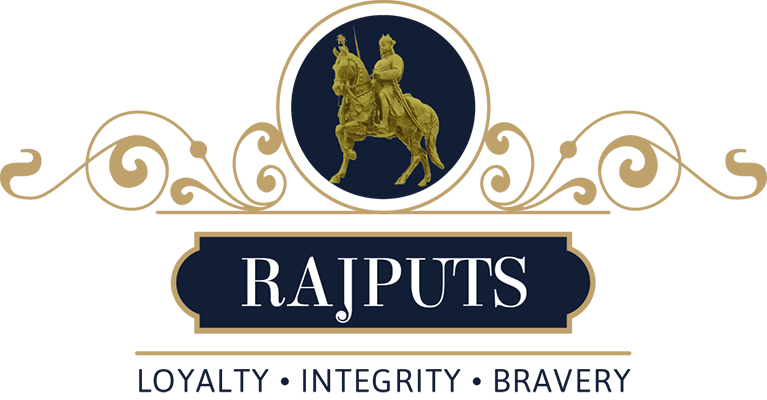











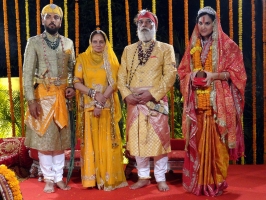



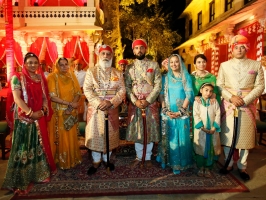
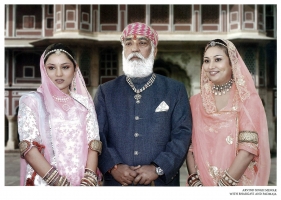
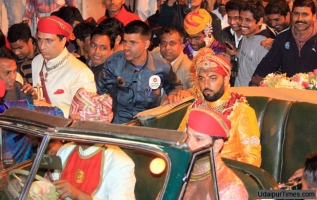








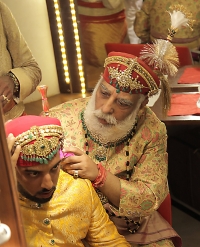
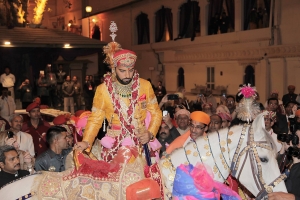



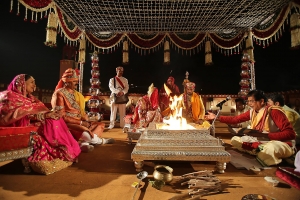
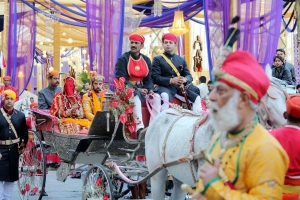












![Maharana Fateh Singh Ji of Mewar [1884-1930]](https://www.indianrajputs.com/i/t/i/thumb200_udaipur_rajasthan-Maharana-Fateh-Singh-Ji-of-Mewar-r-1884-1930-Udaipur-1.jpg)







